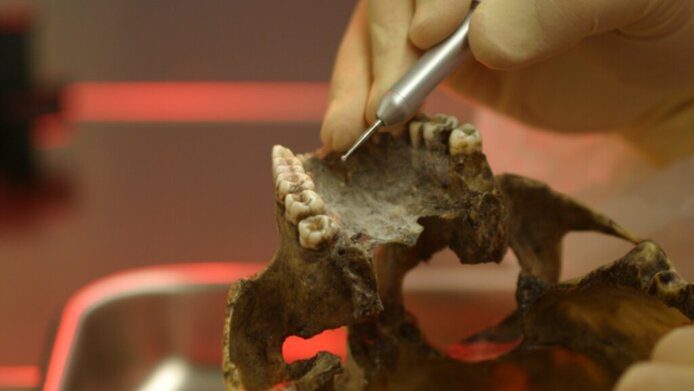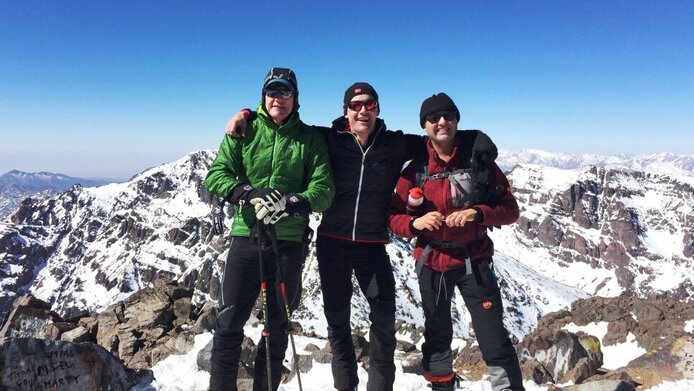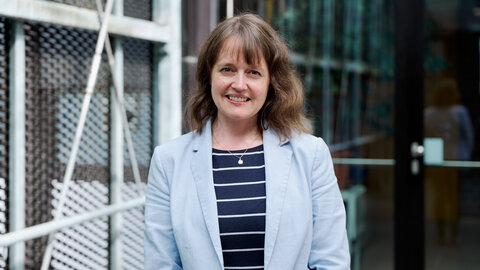The right man for tricky cases

On 28 December 2004, Walther Parson was on a Christmas skiing holiday when a telephone call made him return to the laboratory. Two days earlier a tsunami had claimed 230,000 lives. The Institute of Legal Medicine in Innsbruck had been chosen as one of the most competent laboratories worldwide to help identify the victims. “This was a key moment”, the molecular biologist recalls in the interview with scilog, “we already had a laboratory to examine mitochondrial DNA, but little experience as of then with bone samples or material that was significantly decayed due to environmental influences.”
Difficult and politically sensitive
The greatest enemies for a DNA sample are fire, humidity and sunlight. In a subtropical climate, the tsunami victims had been exposed to both high levels of humidity and high temperatures, which greatly accelerated the degradation of DNA. “Even the task of communicating from Innsbruck to the local emergency teams what samples to take and how to pack and ship them was a challenge, because there had been no comparable cases before”, Parson recalls. For instance, merely talking next to a sample without protection can distort the result of an analysis. Yet, the laboratory managed successfully to analyse all samples and thus make them available for positive identification. Since then, the Institute has been consigned extremely difficult cases, including politically sensitive ones: one of their assignments related to investigations in the case of the group of Mexican students declared missing since October 2014. Since 2008, the Institute has also been working on identifying victims of the putsch in Chile in 1973.
Mitochondrial DNA
Although accounting for just one percent of total analyses conducted at the laboratory in Innsbruck, the analysis of mitochondrial DNA holds special significance. This method is used when there is not enough biological material available for a nucleic DNA analysis. This may be the case for hair shafts or traces invisible to the naked eye. What exactly makes this mitochondrial DNA so special? The cells of all human beings include a nucleus with two copies of nucleic DNA and up to several thousand mitochondria. Each of these mitochondria carries several molecules of mitochondrial DNA, meaning that the cell holds many more copies of mitochondrial DNA than of nucleic DNA. In this way, mitochondrial DNA analysis gives the laboratory an edge because there are more molecular copies available. The analysis of mitochondrial DNA requires optimum equipment and a different scientific approach, because mitochondrial DNA has a different inheritance mechanism: it is exclusively passed on from the mother to her children of either sex, and only the girls will pass it on to the next generation. This enables scholars to look at lines of inheritance that reach far back into our past and constitute direct lines of kinship.
“Out of Africa hypothesis”
These lines of inheritance are of geographical significance, because mitochondrial DNA of people living today can be traced back across the history of human settlement on our planet. And that settlement started in Africa. In the early 1990s, researchers were able to use this analytical method to confirm that humanity originated in Africa and spread across the planet from there. Previously, scholars had argued for an alternative hypothesis maintaining that modern humans came into being simultaneously in different regions of the earth and independently of each other. Mitochondrial DNA and the subsequent analyses of nucleic DNA strengthened the “Out of Africa hypothesis” and provided an argument against the “multiregional hypothesis”. “Today we know that we are all related to each other”, Parson notes, “which clearly refutes racist concepts based on other contexts.”
From apprentice to adviser of the FBI
From the outset, when Parson joined the Institute of Legal Medicine in Innsbruck in 1994, mitochondrial DNA became his pet subject. He is very grateful to the director of the Institute, Richard Scheithauer: “He was farsighted enough to recognise the importance of DNA analysis for forensic medicine at an early point and enabled me to visit laboratories in the USA. I was able to learn from the FBI and the US Army laboratory how they conduct mitochondrial DNA analyses”, Parson relates, adding, “at that time the US had the edge over Europe in this technology, which is not necessarily the case anymore today.” Europe has made up a lot of ground in the meantime. The new concepts of mitochondrial DNA analysis originate in Europe, some of them indeed in Innsbruck. While this gave rise to some differences of opinion and debates in the early years after 2000, the tenets from Innsbruck turned out to be solid. Since 2010, the FBI laboratory has been drawing on the services of Parson as a scientific adviser.
Service contract instead of driving a taxi
This career path is not what he had planned. After an “unexceptional time at secondary school, including repeat years and changing schools” the scholar, now aged 50, started to study biology, a subject he had always been enthusiastic about, at the University of Innsbruck. After graduation he went abroad for several months, travelling widely from Alaska to Ecuador. Once back in Innsbruck he did not opt for an academic career but wanted to earn money by driving a taxi. In these first days after his return the Institute of Legal Medicine was looking for the temporary services of an independent contractor. Although it paid less than taxi driving it was more interesting. “I intended to try my hand at it for six months and then get a ‘proper job’. I’ve been here ever since”, smiles the Tyrolean. “It’s great fun” The rest of his academic career simply fell into place. After the initial six months he was first offered a position in the lower echelons, and then a position for which he needed a PhD, and so he obtained one. When an amendment of the law required the holder of this post to have postdoctoral qualifications, he acquired those as well. Parson makes it sound as though there were nothing to it. “It was never frustrating or exhausting, because the subject holds so much interest for me. I have a wonderful team of 20 extremely motivated co-workers, and it’s great fun” asserts the charismatic Professor.
The “CSI effect”
His enthusiasm is infectious. Working with his students has taught him that one only needs to awaken their interest, and they will perform to the best of their abilities. Student numbers, of course, also play a role, which is why he only teaches small groups. There is lively demand for studying molecular forensic medicine. “We receive at least one application per day”, says Parson and calls it the “CSI effect”. But there is also a downside: “TV series of this kind give people the impression that everything has already been researched. This carries the danger that they might not see the need for additional research”, says the scholar with some concern. At the outset of DNA analysis 25 years ago, a bloodstain the size of a fingernail was required for analysis. Today it’s possible to analyse traces no longer visible to the naked eye. Research is going down the path towards growing efficiency, enabling scientists in the future to examine traces that would not deliver any results today.
Pandora’s box
He views it as extremely critical that DNA analysis has become “sexy” in the past 20 years. Hundreds of companies on the web try to lure customers with promises to use their genetic fingerprint to predict illnesses and talents, determine the appropriate athletic activity for them or even find their ideal partner. Particularly in the USA, private companies are not subject to strict controls and are free to use the data for different purposes or sell them. “People are not aware of what they give away with their DNA information. They are opening Pandora’s box”, warns Parson. One of the largest providers in this market is the US company “23andMe”. It offers private individuals an analysis of their genetic information - at USD 99 plus shipping. The saliva samples people send in are screened for genetic illnesses and other predispositions. The results also include information about geographical origin. In 2013, the company was granted a patent for a process enabling them to make predictions about planned offspring. “Last October a newspaper reported that 23andMe sold 800,000 data records to a pharmaceutical giant”, reports Parson and cautions “the percentage probability assessed for a disease can be reflected in higher insurance premiums and have an impact on a person's future employment. The impact is not restricted to one’s own life, one also affects the information privacy of one’s next-of-kin!”
Tasks for the legislator
The technology has advanced so much that one can now quite easily identify a third-degree cousin. The other side of the coin: one never knows what this may mean for the person involved. Take the case of a man who financed his studies by donating sperm in the 1970s and is now identified as a father. “25 families are looking for the biological father, and the company boasts it can find this man. By now he may have a family of his own and wish to be left alone. At the time when he donated the sperm he could not sign a document saying he did not want to be exposed to such a test, because that test didn’t exist then”, is how Parson illustrates the problem. He considers legislation to be the only source of protection for the individual. The same risk does not exist for DNA investigated by court order, because the law forbids such data to be used for any other purpose. It is at this level that he provides his expertise to the Austrian Ministry of the Interior as an adviser in order to inform the authorities about what information can be gleaned from DNA. Parson comments that he can conduct his own research without any pangs of conscience, because forensic medicine cannot and does not even intend to keep up with the cutting-edge research that drives such developments. “Compared to these institutions, forensic medicine lags behind by 10 to 15 years. It does so for good reason: forensic analysis needs to have a very sound technical and statistical basis, because it is used by the courts to assess evidence and may decide on a person’s life and future”, Parson explains.
Parson's team established molecular genetic methods used for identifying the tsunami victims in Sri Lanka and victims of the Pinochet regime. The laboratory is also entrusted with historical cases such as the one concerning the Russian Tsar's family, Friedrich Schiller and Günther Messner. In 2013, DNA analysis enabled Parson to find 19 living Tyroleans who share genetic properties with Ötzi, the Iceman discovered in 1991.
Spectacular cases
Since their successful identification of the tsunami victims and their involvement in other headline-making cases, the Institute of Legal Medicine in Innsbruck has been considered a reference laboratory for challenging samples and for mitochondrial DNA analysis in particular. The team in Innsbruck receives commissions from the FBI, law courts, the police and international NGOs. In the book he published in 2014 under the title Irgendwann kommt alles ans Licht (approx. ‘truth will out’) Walther Parson recounts, for instance, how his team identified the missing Romanov children from the family of the Russian Tsar and solved the enigma of Friedrich Schiller’s skull.
Discovering the direct descendants of Ötzi the Iceman …
Another spectacular feat was the identification of 19 living descendants of the Tyrolean Iceman also known as Ötzi – actually a “by-product of a more meaningful research effort”, as Parson notes. In 2013, his team examined the Y chromosomes of almost 4,000 Tyrolean men to gain insights into the immigration of humans in the Alps during the Neolithic Period about 10,000 years ago. The Upper Inn Valley was part of the central branch of an important Roman trade route from Rome to Augsburg. The reason why the scientists focused on the Y chromosome which is inherited from father to son was the patrilocal tradition: the eldest son inherited the farm and founded a family there, while the other children moved elsewhere. The Y chromosomes observed in this region today with above average frequency are up to 8,000 years old, which means that the population has hardly changed since the first individuals came to settle in that region. There are a number of reasons for this: apart from the patrilocal lifestyle, the local resources were just about sufficient for the existing population and mostly precluded any new immigration. Even epidemics and wars that changed the population structure were unable to distort this genetic signal. Comparing the data of the 4,000 volunteers with the Ötzi chromosome was an add-on benefit, so to speak.
… created media hype
An article in the daily newspaper Der Standard on the original study did not create any media stir. Two weeks later, a journalist from the Tyrolean office of the Austrian press agency APA interviewed Walther Parson. In addition to speaking about the study results, he also mentioned the matchings that had been found with the “man from the ice”. This news item was an instant hit: “All over the world, from the Wall Street Journal to an Australian magazine in Perth the media reported that 19 living descendants of Ötzi had been found”, the scholar recalls. Even today he still receives requests from people who insist on sending him a sample because they believe they are related to Ötzi. “For us here it is obvious anyway that we are all related. But at that point I realised just what kinship can mean to other people”, Parson reflects.
Grounded by mountains
A frequent traveller because of his profession, sometimes on several continents within one week, the father of three daughters finds time to unwind and recharge in the mountains. Hillwalking in the summer, ski tours in the winter. The ski tour he does most often starts right at his front door. “Three minutes on my skis are enough to get me into a rhythm that is suffused with truly magical power”, enthuses the fervent Tyrolean. In the mountains he finds tranquillity and, sometimes, solutions to problems that seemed unsolvable at the laboratory.
Walther Parson studied biology at the University of Innsbruck. In 1997, as a university assistant, he was the man in charge of establishing the National DNA Database Laboratory there. Appointed Associate Professor in 2001, he was entrusted with the direction of the High Throughput DNA Databasing Unit and the Forensic Molecular Biology research area at the Institute of Legal Medicine of the Medical University of Innsbruck (GMI). As of 2000, he has been a member of the International Commission on Missing Persons (ICMP) which inter alia identified victims of the war in Yugoslavia by means of DNA analysis. In 2007 Parson became an associate member of the European Academy of Forensic Science and in 2009 he was elected as an active member of the German Academy of Sciences Leopoldina.







